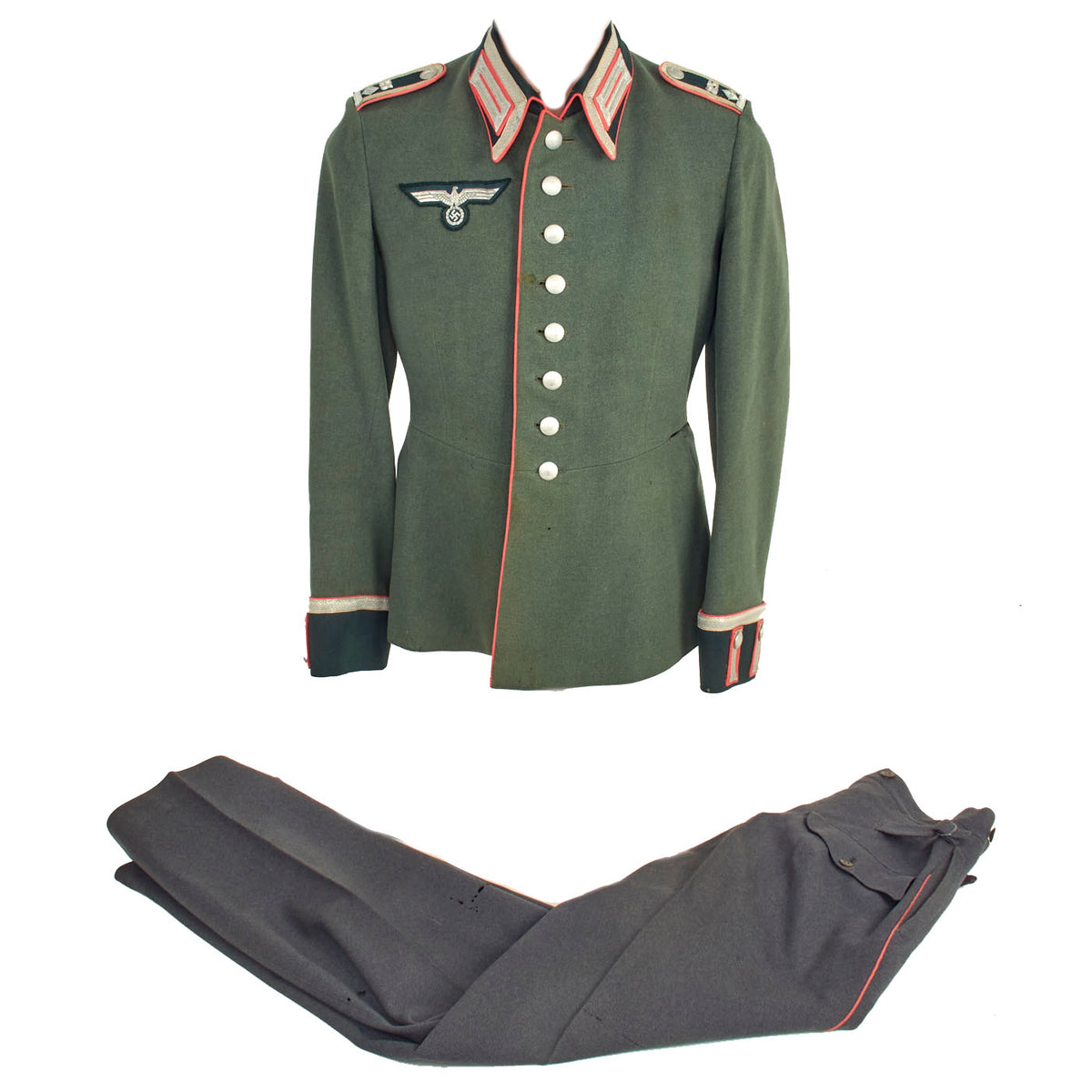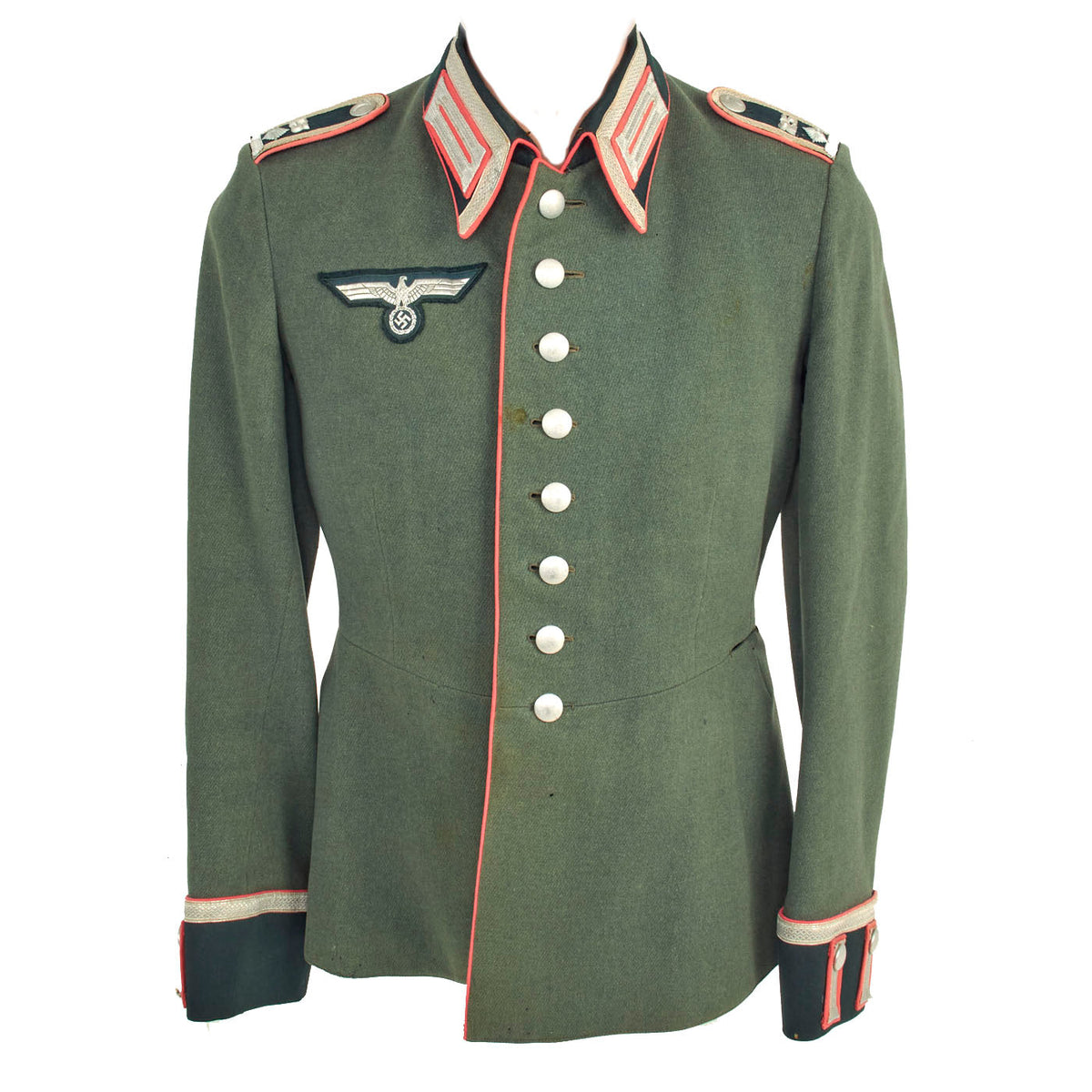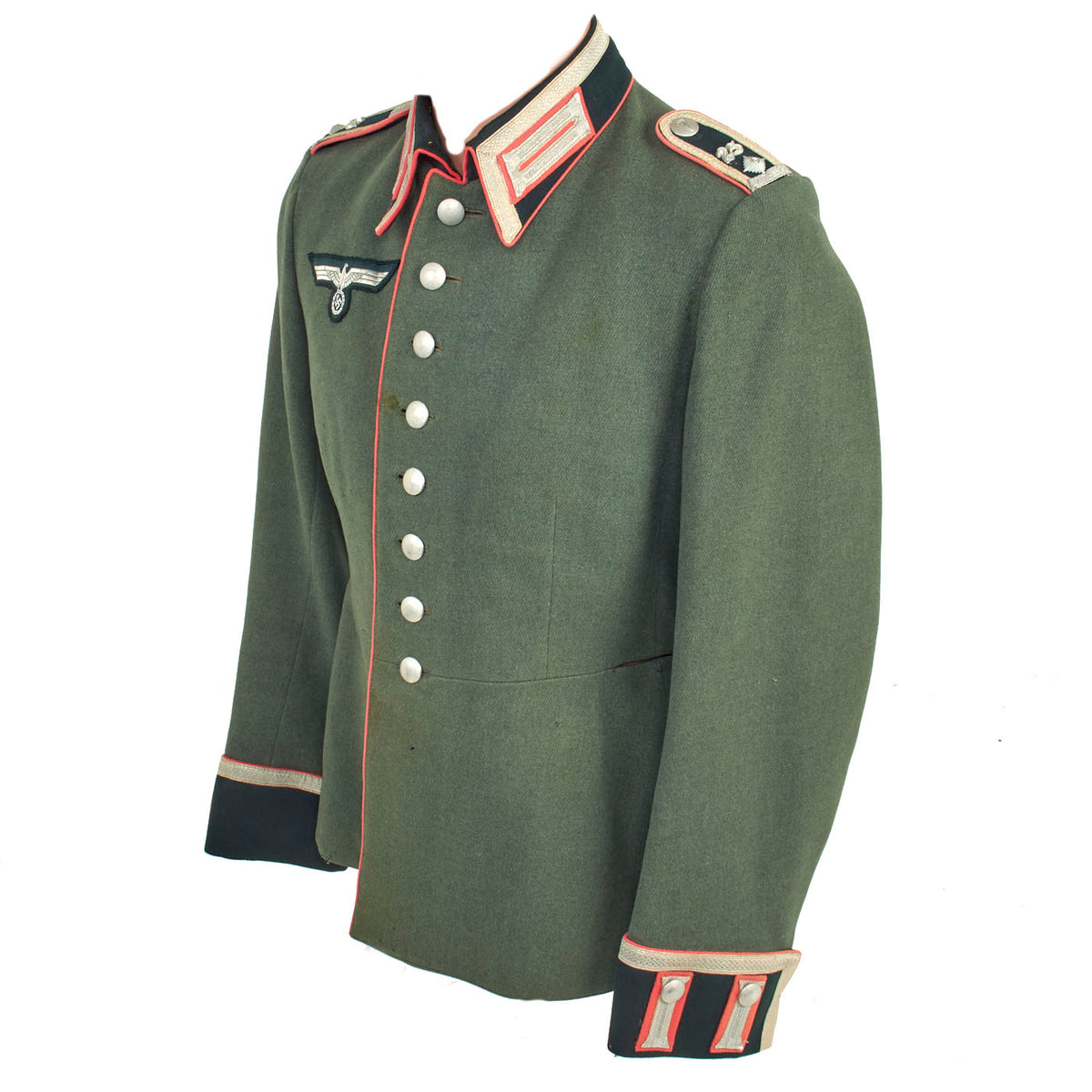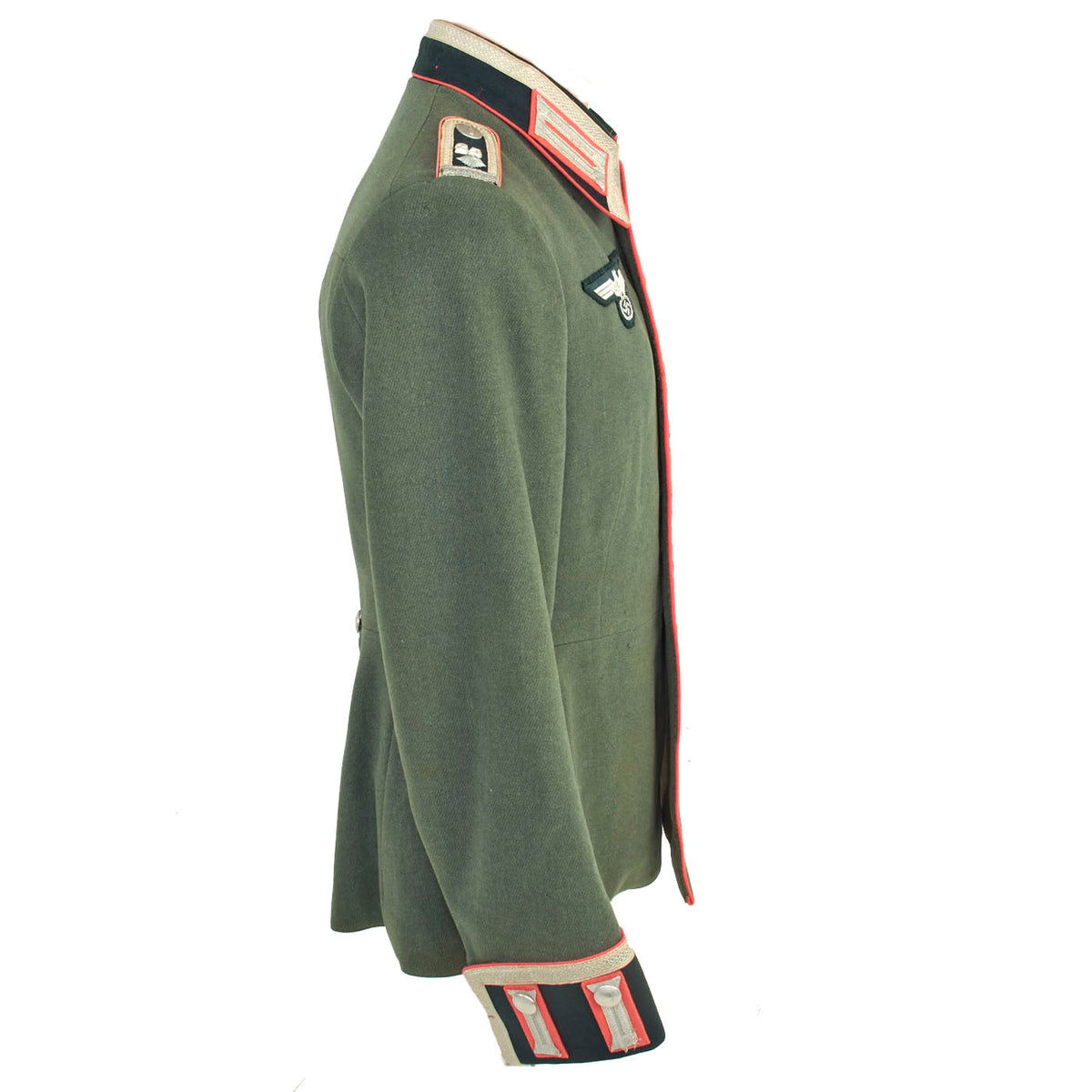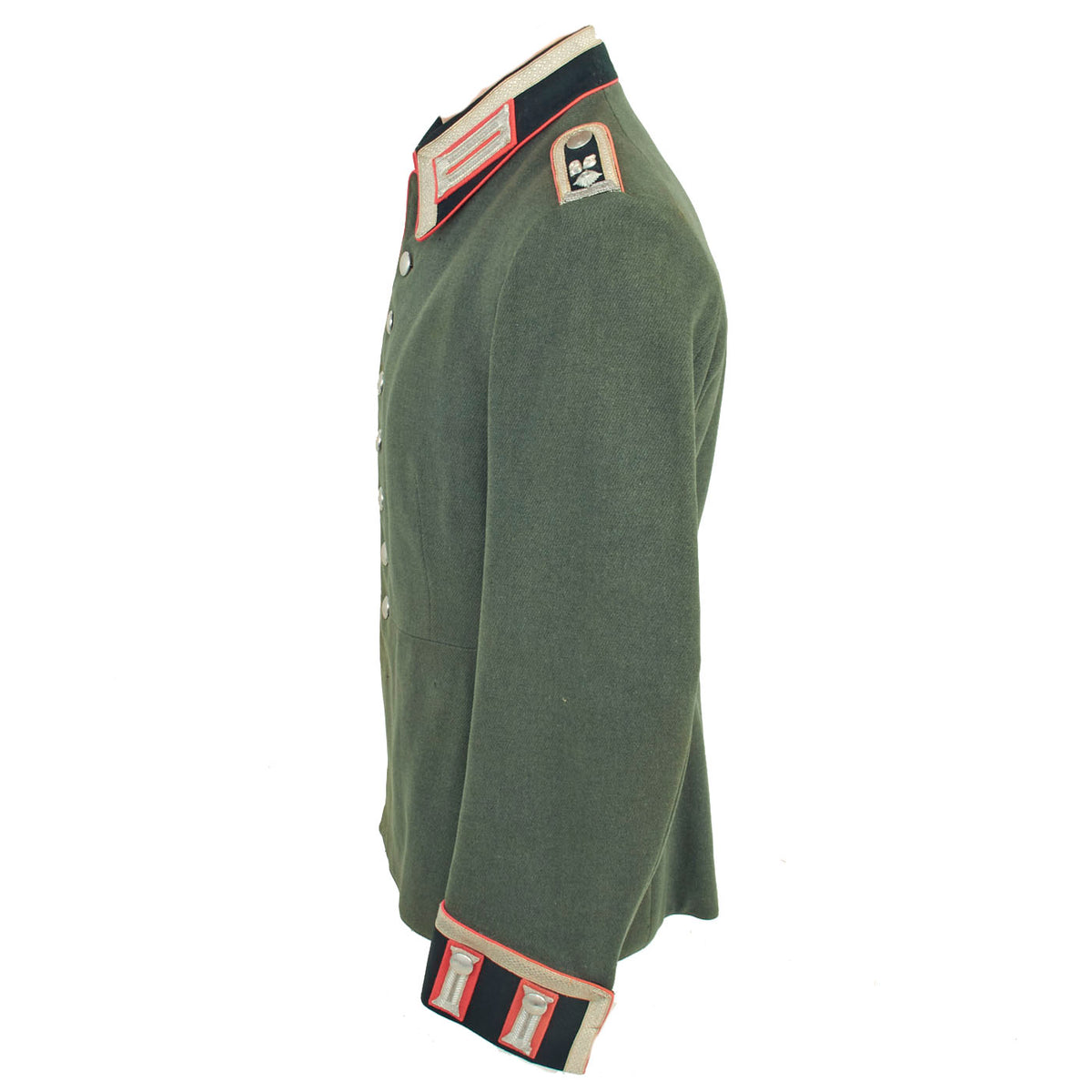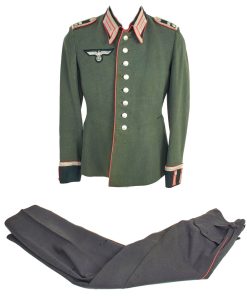Original German WWII 25th Panzer Regiment Feldwebel’s M35 Waffenrock Dress Tunic Uniform with Pants Original Items
$ 1.595,00 $ 398,75
Original Item: One-of-a-kind. The M35 dress tunic was introduced for wear by all ranks on June 29TH 1935 as the walking out, parade and ceremonial dress with the piped, stone grey long pants. The design of the M35 dress tunic was based on the Imperial German army’s service tunic but was a different color and generally of much higher quality. Originally all personnel were issued two M35 dress tunics but manufacture was discontinued in late 1939 or early 1940 and was to be reinstated at the successful conclusion of the war. Regulations of March 21ST 1940 stated that the M35 dress tunics that were no longer suitable for dress wear were to be modified and reissued to personnel of the replacement and reserve units for every day wear. Officers and certain senior NCO ranks were responsible for purchasing their own uniforms and as a result were allotted a clothing allowance through the army’s Kleiderkasse, (Clothing Account), system. The Officers and certain senior NCO’s could choose to purchase their uniforms from the armed forces clothing depots or to privately purchase garments of higher quality. Although enlisted personnel were issued their uniforms from government supplies they were also permitted to purchase privately tailored uniforms although the price may have been restrictive.
This is a beautiful Heer Panzer Feldwebel’s (Armored / Tank Technical Sgt.’s) M35 Waffenrock dress tunic, which does not have any maker insignia on it. These dress uniforms were fitted and bespoke, so often there would be no maker marking at all. The base material of the uniform is made of a fine feldgrau colored wool. The wool shows no signs of any physical damage by misuse but does display some light mothing and stains. It has the correct 8 button front closure, with hook and loop collar closure, though one hook is bent. As this is an early example, parts of the uniform like the cuffs, collar, etc are dark green, not the later black adopted for panzer troops.
The collar is wrapped in a dark-green wool, and is decorated a strip of 15mm flat silver diamond woven bright aluminum braid (Unteroffoziers-Tressen), sewn around the top an front of the collar. The base material of the collar piping and the two NCO litzen on each side of the collar opening is Rosa (Rose-pink), which was the Waffenfarbe (corps color) during WWII for the Panzers (Armored Troops) and Panzerjäger (Tank Destroyers). The two litzen themselves are woven from a fine silver flatware thread, and are the correct “dress” style for an M35 Waffenrock. The collar, and its insignia, are without any noticeable damage or mothing.
The “sew-in” style shoulder straps (Schulterklappen) of this Waffenrock have a dark green base wool, which is piped in Rose-pink, and has a silver diamond-woven tress border all the way around. ONE rank pip is present on the shoulder boards, indicating the rank of Feldwebel, an NCO rank equivalent to a U.S. Army Technical Sgt. We noted that the strip of tress on the ends is a later addition, so the owner was originally a Unteroffizier (Sergant), who was later promoted to Unterfeldwebel and then Feldwebel.
Both shoulder straps also bear the metal number 25, a unit marking that indicates they were part of the Panzerregiment 25 (PzRgt 25), which was part of the 7th Panzer Division, also known as the “Ghost Division”. The pebbled aluminum buttons holding the ends of the shoulder straps down both bear number 7, indicating the 7th company of the regiment. The lower right interior of the tunic has a unit marking that is faint, but looks to confirm this unit.
The front breast eagle is a correct EM/OCO’s Pattern silver thread BEVO embroidered example. The eagle is without damage and is originally sewn to the tunics breast by very neat hand stitching, some of which has popped over the years. Eight silvered metallic buttons adorn the front of the tunic and all appear to be originally attached, with maker names on the back. The lower French style cuffs of the sleeves are adorned with the correct Rose-pink piping and litzen.
The interior is lined with what looks to be a cotton and rayon blend, and is in very good service used condition. There are some small tears, as well as areas where the stitching between pieces of fabric has come undone. There are a few areas of light mothing, almost impossible to avoid on a wool uniform of this age.
The included trousers are in the Stonegrey “Steingrau” color in a satinet wool, with correct Rose-pink Panzer Armored piping, and are in very good condition. They exhibit light wear and staining in line with the condition of the tunic. There are also some areas of moth damage
This lovely named Panzer NCO’s Waffenrock Uniform comes ready to research and display!
Approx. Measurements:
Tunic:
Collar to shoulder: 9”
Shoulder to sleeve: 25”
Shoulder to shoulder: 15.5”
Chest width: 18″
Waist width: 17.5”
Hip width: 21”
Front length: 29.5″
Pants:
Waist: 15.5″
Inseam: 31.5″
The 7th Panzer Division (German: 7. Panzer-Division) was an armored formation of the German Army in World War II. It participated in the Battle of France, the invasion of the Soviet Union, the occupation of Vichy France, and on the Eastern Front until the end of the war. The 7th Panzer Division is also known by its nickname, Ghost Division.
The division met with great success in France in 1940 and then again in the Soviet Union in 1941. In May 1942, the division was withdrawn from the Soviet Union and sent back to France to replace losses and refit. It returned to Southern Russia following the defeat at Stalingrad, and helped to check a general collapse of the front in a series of defensive battles as part of Army Group Don, and participated in General Erich von Manstein’s counterattack at Kharkov. The division fought in the unsuccessful offensive at Kursk in the summer of 1943, suffering heavy losses in men and equipment and was further degraded in the subsequent Soviet counteroffensive.
Through 1944 and 1945, the division was markedly understrength and continuously engaged in a series of defensive battles across the eastern front. It was twice evacuated by sea, leaving what was left of its heavy equipment behind each time. After fighting defensively across Prussia and Northern Germany, the surviving men escaped into the forest and surrendered to the British Army northwest of Berlin in May 1945.
Fast Shipping with Professional Packaging
Thanks to our longstanding association with UPS FedEx DHL, and other major international carriers, we are able to provide a range of shipping options. Our warehouse staff is expertly trained and will wrap your products according to our exact and precise specifications. Prior to shipping, your goods will be thoroughly examined and securely secured. We ship to thousands clients each day across multiple countries. This shows how we're dedicated to be the largest retailer on the internet. Warehouses and distribution centres can be located throughout Europe as well as the USA.
Note: Orders with more than one item will be assigned a processing date depending on the item.
Before shipping before shipping, we'll conduct a thorough inspection of the items you have ordered. Today, the majority of orders will be delivered within 48 hours. The delivery time will be between 3-7 days.
Returns
The stock is dynamic and we cannot completely manage it because multiple stakeholders are involved, including our factory and warehouse. So the actual stock may alter at any time. It's possible that you may not receive your order once the order has been made.
Our policy is valid for a period of 30 days. If you don't receive the product within 30 days, we are not able to issue a refund or an exchange.
You can only return an item if it is unused and in the same state as the day you received it. You must have the item in its original packaging.
Related products
Uncategorized
Uncategorized
Armoured Fighting Vehicles of the World: AFVs of World War One (Hardcover Book) New Made Items
Uncategorized
Uncategorized
Uncategorized
Uncategorized
Uncategorized
Uncategorized
Uncategorized
Uncategorized
Uncategorized
Uncategorized
Angolan Rebel 1970s era 60mm Inert Display Mortar from Angolan Civil War Original Items
Uncategorized
Uncategorized
Uncategorized
Uncategorized
Uncategorized
Uncategorized
Band of Brothers ORIGINAL GERMAN WWII Le. F.H. 18 10.5cm ARTILLERY PIECE Original Items
Uncategorized
Uncategorized
Australian WWII Owen MK1 Machine Carbine SMG Custom Fabricated Replica with Sling Original Items
